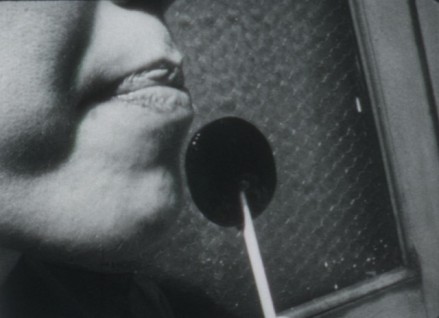
Films
- Read More
 Experimental
ExperimentalInformation
Hollis Frampton16mm, black and white, silent, 4 minRental format: 16mm - Read More
 Experimental
ExperimentalManual of Arms
Hollis Frampton16mm, black and white, silent, 17 minRental format: 16mm - Read More
 Animation
AnimationHeterodyne
Hollis Frampton16mm, color, silent, 7 minRental format: 16mm - Read More
 Experimental
ExperimentalStates
Hollis Frampton16mm, black and white, silent, 17 minRental format: 16mm - Read More
 Experimental
ExperimentalSnowblind
Hollis Frampton16mm, black and white, silent, 5.3 minRental format: 16mm - Read More
 Experimental
ExperimentalMaxwell's Demon
Hollis Frampton16mm, color, sound, 4 minRental format: 16mm - Read More

Process Red
Hollis Frampton16mm, color, silent, 3.3 minRental format: 16mm - Read More
 Experimental
ExperimentalSurface Tension
Hollis Frampton16mm, color, sound, 10 minRental format: 16mm - Read More
 Experimental
ExperimentalPrince Ruperts Drops
Hollis Frampton16mm, black and white, silent, 7 minRental format: 16mm
Biography
"Hollis Frampton is known for the broad and restless intelligence he brought to the films he made, beginning in the early '60s, until his death in 1984. In addition to being an important experimental filmmaker, he was also an accomplished photographer and writer, and in the 1970s made significant contributions to the emerging field of computer science. He is considered one of the pioneers of what has come to be termed structuralism, an influential style of experimental filmmaking that uses the basic elements of cinematic language to create works that investigate film form at the expense of traditional narrative content. Along with Michael Snow and Stan Brakhage, he is one of the major figures to emerge from the New York avant-garde film community of the 1960s.
Frampton's legendary intellect and equally legendary stubbornness announced themselves early. At the age of 15, he applied on his own volition to the prestigious Phillips Academy and was accepted on a full scholarship. Toward the end of his studies there, he was offered a scholarship to Harvard, only to have it rescinded after he failed to graduate by purposefully failing a required American history class. He spent several years at Western Reserve University in his native Ohio, studying a wide range of subjects but never attaining a degree. In 1958, he moved to New York with the intention of becoming a poet, but he soon abandoned that idea in favor of photography. His move to film in the early '60s coincided with the rise of avant-garde filmmaking in New York, centered around Jonas Mekas' Filmmakers Coop.
It was Frampton's philosophy that film, at its most fundamental, consists of a series of images that have to be arranged in some way. He saw this as a philosophical problem and believed that arranging images into a narrative was only one of many possible solutions. Instead, he often based the structures of his films on mathematical and scientific concepts. Prince Ruperts Drops takes its title from an object used in scientific instruction. The title and structure of Zorns Lemma come from "Zorn's lemma," a controversial mathematical concept. Frampton was astonishingly well-read, not only in mathematics and science, but in philosophy and literature as well. He was a great admirer of modernist writers Gertrude Stein and James Joyce, and his films reflect a breaking down of film language similar to the revolutionary ways Stein and Joyce reconfigured fictional prose. Like Joyce, Frampton moved from shorter works to much longer ones. After making mostly short films in the '60s, he spent several years on the seven-part Hapax Legomena (which includes his most famous film (nostalgia)), then spent the last decade of his life working on Magellan, a 36-hour film meant to be seen at specific intervals over the course of 371 days, which was left unfinished at the time of his death." - Tom Vick, All Movie Guide
